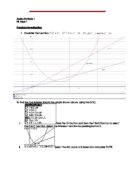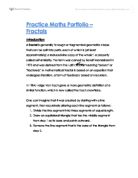.
As expected,
represents the axe of symmetry between the two functions.
If we want to generalise an expression for the shadow function, we need to reconsider the definition of the shadow function in itself. It has the same vertex, but opposite concavity. Thus, it is reflected by the line passing through the vertex and horizontal to the x-axis:
.
Thus:
So from the first equation:
,
which can be substituted in the second equation to give:
Let us observe if the graphical representation of a quadratic and its shadow function helps us determine the complex roots of the original function.
Considering
with roots
and its shadow function
with roots
If we observe the roots of the shadow function (the x-intercepts 2 and 6), and treat them as if they were two opposite points of a circle with centre A, the line passing through A, parallel to the y-axis, intercepts the circle to create two points C and D. These two points, if imagined as points on the Argand plane (where the real part of a complex number is represented by the x-axis, and the imaginary part by the y-axis), display the complex roots of the original function
being
.
Part B: Cubic Polynomials
Now, considering the cubic function
The shadow function in this case is another cubic function
which shares two points with
,
has opposite concavity and its zeros are -2 and 3
2. The shadow generating function is a line passing through the two points of intersection.
As we know the roots, we can determine the equation for the shadow function:
With this equation, we can now find the points of intersection between
and
, by equating both functions.
if
or
where
Thus, the two points of intersection are
and
From this, we can calculate the shadow-generating function:
Where
Giving
Allowing us to express
in terms of
and
.
I will now investigate similar cubic functions to see if the relationship between
and
remains the same.
Let us consider
and
Graphed:
The shadow generating function is given by the equation
,
Expressing
in terms of
and
:
Which is the same relationship as with our previous cubic. Let us see if this pattern holds true with another similar cubic.
with shadow function
Graphed:
The shadow generating function can be read to be
,
Again, expressing
in terms of
and
:
It seems that, just like in the case of the quadratics, the relationship between
,
and
is given by the equation:
Let us try to prove this statement, by generalising the functions
,
and
.
We have:
.
These two cubics intersect where
,
The points of intersection are thus
and
.
And the equation of the line passing through both points
.
Where
Giving
The relationship between
,
and
:
My assumption has been proven correct.
The relationship between
,
and
in the case of cubic polynomials is exactly the same as for quadratics. Perhaps, the zeros of
can also be used in the same way to graphically determine the real and imaginary components of the complex zeros of
.
Taking into consideration the function
The roots are
and
, as proven in part A.
The shadow function of
is defined as
, with roots
and
.
Graphed:
Using the same method as for the quadratics, focusing only on the roots of the shadow function
and
(as both functions share the same root
) we treat them once again as two opposite sides of a circle and imagine the line passing through its centre, parallel to the y-axis. The points created by the intersection of the line and the circle, C and D represent the complex roots
of the original cubic, when interpreted as points on the Argand plane.
Part C: Quartic Polynomials
With quartics, we have two different cases to consider, as complex roots always come in pairs (conjugates). The first case, with two complex roots and two real roots, and the second case, with four complex roots.
C.1 Two Complex and Two Real Roots
Let us start with the first case, by considering the function
where
.
The function has two real roots
and two complex roots
.
Its shadow function is
sharing the same real roots
but instead of two complex roots it has two more real roots
.
The points of intersection can be calculated by equating both functions:
When
The fact that the two curves have three points of intersection makes it difficult to figure out the shadow-generating function
.
The most reasonable assumption is that the relationship between
,
and
is the same as in the case of the quadratics and cubics.
But I do not and I cannot know if this is true as I am not given any definition of
in the quartics case. In fact, the only information received about the shadow-generating function is that it passes through the two points of intersection between the two cubic functions in part B. Even though this is not a general definition, I might just as well check if my assumed shadow-generating function passes through the three points of intersection of our quartic's. I know that
passes through
and
, so if
also passes through these three points, it has to intersect
at these points.
When
Thus,
passes through the three points of intersection of our two quartic functions.
When defined as the function passing through the three points of intersection between the original quartic and its shadow function, with equation
, then the relationship between
,
and
is:
The relationship between
,
and
is thus (expected to be) the same as in the case of quadratics and cubics. It seems likely that the zeros of
can also be used in the same way to determine the real and imaginary components of the complex zeros of
.
To test this, let us take the function
with roots
and
. Its shadow function is
with roots
and
.
Graphed:
If we once again focus on the roots of
, which are not shared by both functions, and using the same method with the circle, we obtain two points E and F, which would both represent the two complex roots in the Argand plane,
.
C.2 Four Complex Roots
Let us consider the function
where
.
The two pairs of complex roots are
and
.
Its shadow function is
with zeros
and
.
Choosing
,
,
,
as an example,
We obtain
and
.
Graphed:
On the graph, I could not identify any points of intersections which makes it impossible for me to figure out the shadow-generating function.
Yet, I assume that the "circle"-method to determine the complex roots of
will still work.
To show this I will use the function
with roots
and
.
The shadow function will have roots
and
with equation:
Graphed:
As we have two pairs of conjugate roots in this case, we will also have to draw two circles, with centre A and C (representing the
and
parts of the real roots under the form of
and
) and radius
and
respectively. The lines passing through A and C and parallel to the y-axis intercept the circles at E, F and G, H. The new points represent, as expected, the complex roots
and
when interpreted on the Argand plane.
Conclusion:
In this assessment, I have investigated and proven the relationship between quadratics and cubics with complex roots and their shadow-functions:
. I also showed that, when knowing the equation of the shadow function, you can easily, graphically identify the complex roots of the original function, with my "circle"-method.
However, the case of quartics is more complicated. First of all, there are two different cases to consider:
The first case with two complex roots allowed me to define the shadow-generating function as
, maintaining the above stated relationship.
But for the second case with four complex roots I failed to identify the shadow-generating function.
Yet, both cases still permitted me to graphically determine the complex roots of the original function from key-points along the x-axis of the shadow-function.








